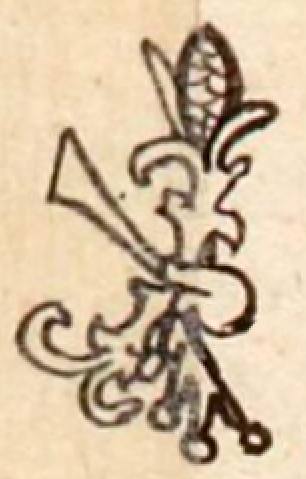Itleuhceuh (Verg10v)
This black-line drawing of the compound glyph for the personal name Itleuhceuh (“His Fire Has Been Snuffed Out,” attested here as a man’s name) shows a complex array of elements, almost all in a frontal view. They are challenging to interpret. Most prominent are fire (tletl) and the verb to snuff out (cehui). At the top is a maize plant with a prominent cob of corn (centli). This comes to play as a part of the phonetic value for the end of the name (-ceuh), from cehui. What may be an agricultural digging stick (huictli) that comes off the left side may be providing additional phonetic value for the "hui" ending in the verb cehui. To provide a fuller semantic impact of the verb cehui (for which ceuh is a form), the writer has put both a flame (tletl) and water (atl), perhaps to indicate the fire being put out. The tletl, of course, has a prominent role, comprising the "tleuh-" part of the name. The possessive pronoun ("I-") is not shown visually. The role of the lips (tentli) is unclear; perhaps it is there to imply a blowing out of the flame. The lips are shown in profile, facing toward the reader's left.
Stephanie Wood
cibeia.ytleuhceuh
1539
Jeff Haskett-Wood
huictli, coa, flamas, fuegos, labios, agua, maíz, mazorcas

tle(tl), fire, https://nahuatl.wired-humanities.org/content/tletl
cen(tli), maize cob, https://nahuatl.wired-humanities.org/content/centli-0
cehui, to snuff, put out, https://nahuatl.wired-humanities.org/content/cehui
i- (possessive pronoun), third person singular, https://nahuatl.wired-humanities.org/content/i
Codex Vergara, folio 10v, https://gallica.bnf.fr/ark:/12148/btv1b84528032/f28.item.zoom
The non-commercial reuse of images from the Bibliothèque nationale de France is free as long as the user is in compliance with the legislation in force and provides the citation: “Source gallica.bnf.fr / Bibliothèque nationale de France” or “Source gallica.bnf.fr / BnF.” We would also appreciate a citation to the Visual Lexicon of Aztec Hieroglyphs, https://aztecglyphs.wired-humanities.org/.





